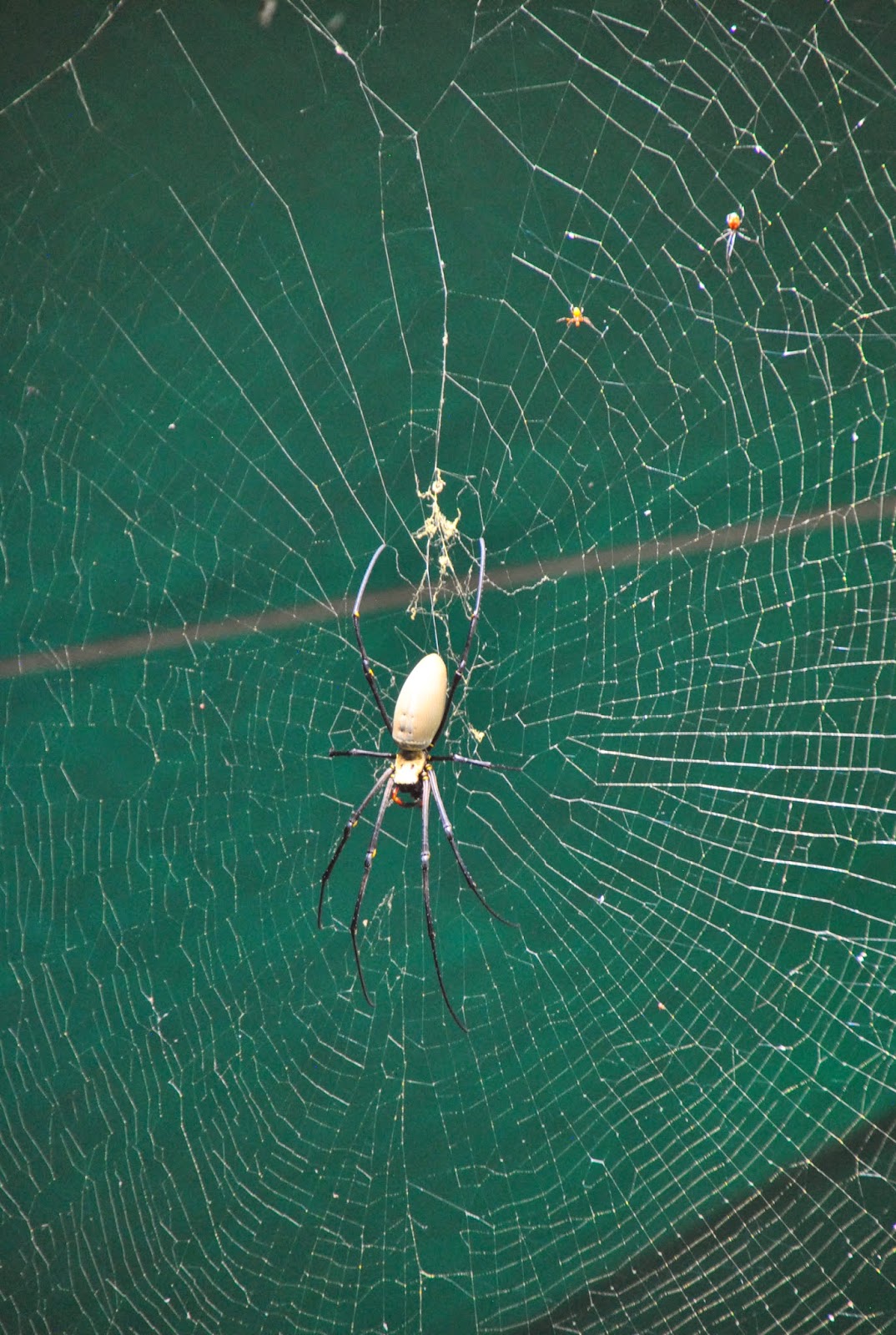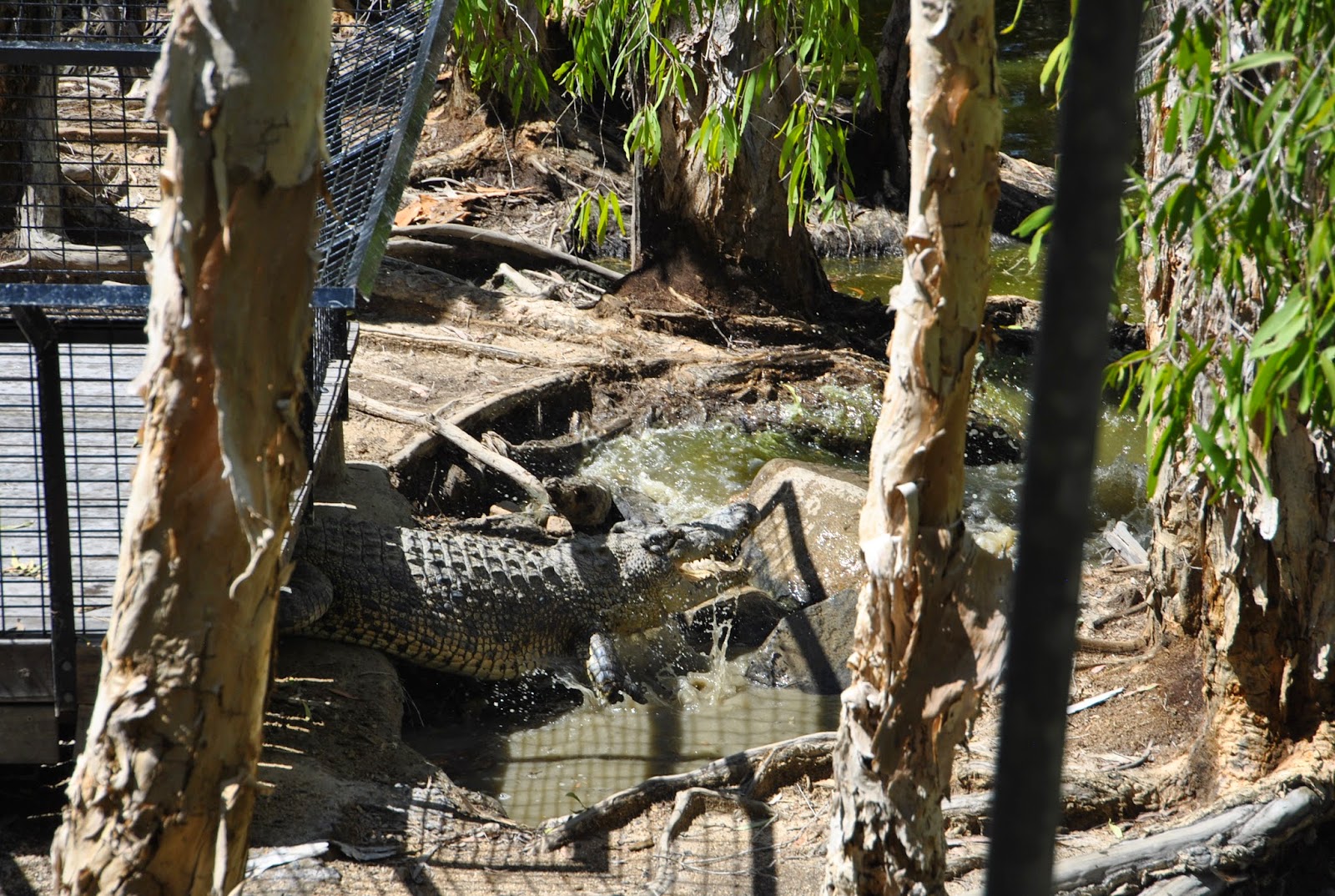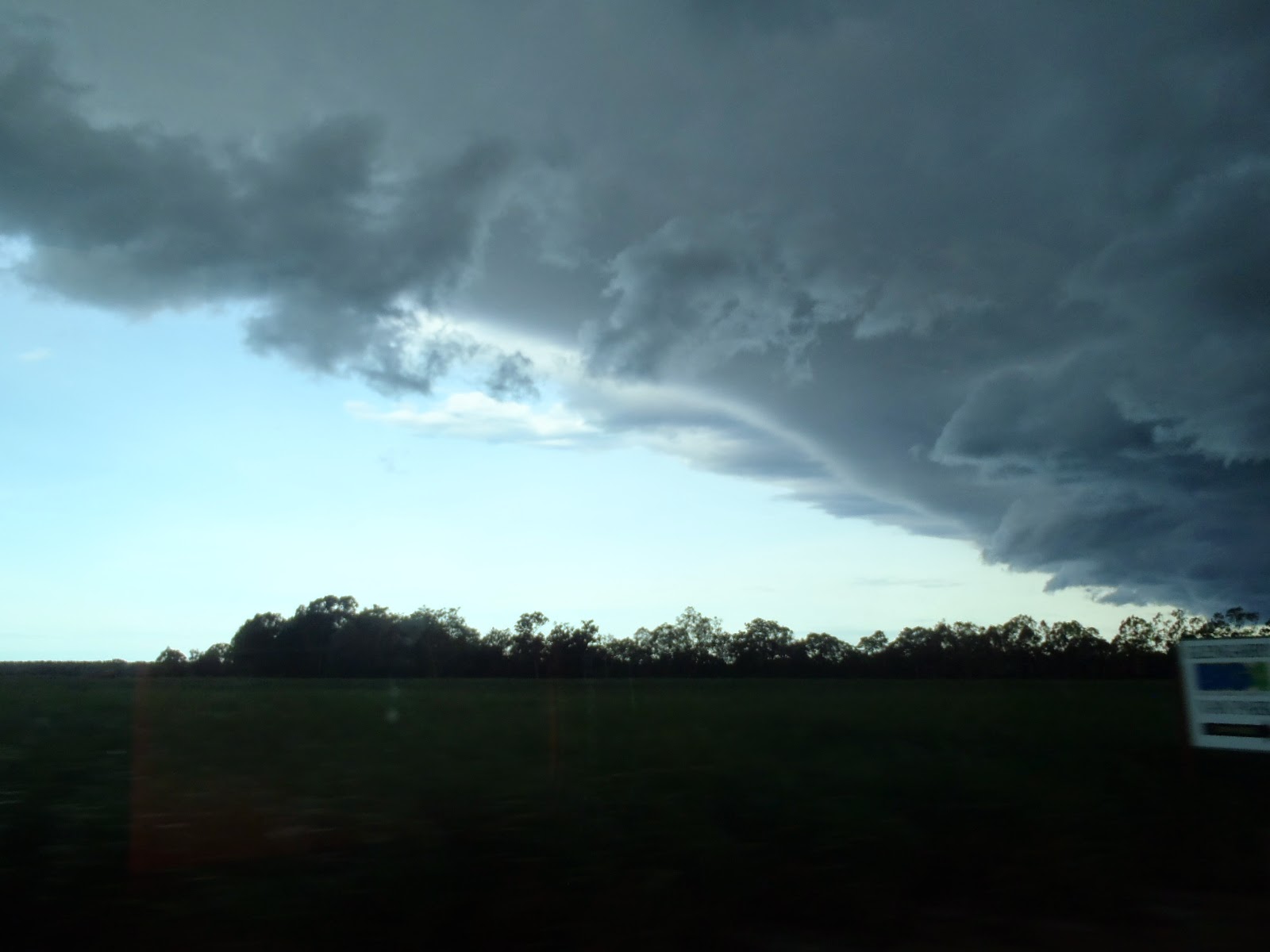We thought it was hot and humid at Uluru - then we got to
Cairns (that's Cahnz, mate!). Flying in, we could see the lush green and the
blue water and expected a bit of relief, but when we stepped off the plane it
was just as hot and even more humid than before.
We were staying in a little place called Palm Cove about 30
minutes outside of Cairns. Georgina said that they used to stay at Kewarra
Beach, about 5 minutes closer, but apparently even more remote. At least Palm
Cove has a little shopping area and a few beachside restaurants. The Reef House
started life as a private home built by a bookie (in case we haven't mentioned
it yet, it seems that the Aussies come in second only to the Chinese when it
comes to gambling) in 1958. He apparently got 'the best swimming pool in north
Queensland' as debt repayment by a swimming pool builder. It was purchased by a
retired Brigadier in 1972, who expanded the number of rooms but still maintained
that private guest atmosphere. Here are a few pictures from around the resort:
 |
| Reef House at Palm Cove |
 |
| Our room |
 |
| Our terrace, complete with counter, wet bar and fridge, overlooking the pool |
 |
| The freshwater pool; they also had a saltwater pool |
 |
| The beach across the street |
We had the rest of the afternoon to relax a bit. Working on
a blog post was on the agenda, but we found that the internet access was really
spotty (non-existent, actually), which is apparently not unusual in the area,
so not only were we not able to post, we couldn't even access e-mail. Not a
huge concern for us, but some of our fellow travelers spent quite a bit of time
in one area or another trying to connect.
A quick word on the area we were visiting. It is actually
where two World Heritage listed areas meet - the Wet Tropics of Queensland
World Heritage Area and the Great Barrier Reef. If you can handle the humidity
there is a huge list of things you can do. We keep forgetting that this is the
height of summer, and most Aussies, when they visit (and many do), will come in
their winter instead, when the weather is more reasonable and warmer than in
Sydney, Melbourne or Brisbane.
On Monday morning we headed out for our day on the Great
Barrier Reef. Many of us had really been looking forward to this as one of the
highlights of the tour. We drove for about 45 minutes along the coast to Port
Douglas and boarded one of the Quicksilver Wavepiercer Catamarans headed for
their permanent pontoon at Agincourt Reef.
 |
| One of Quicksilver's other catamarans. You can see why they're called 'wavepiercing'. Each of the pontoons even has a bulbous nose to cut the waves. |
The catamaran is quite large and comfortable, and Tauck tour
members had the added bonus of being able to board about 1/2 hour before the
rest of the masses and get a private talk from one of the marine biologists on
board. It may not sound like much, but when you realize that there were about
400 people on the boat, and it was almost impossible to hear the biologist's
presentation while underway, it was a real advantage. The trip out to the reef
took about 1 1/2 hours, as the Agincourt Reef is one of the outer reefs. Not more
than 2 km out from there, the ocean depth drops from 10-20 meters to 500 metres
and then even farther, as it is at the edge of the Australian continental shelf. The pontoon, when we arrived, was quite impressive. This was where all the diving and snorkeling equipment was stored, lunch was served, and everyone could access the water.
 |
| This is a photo from the brochure, showing the catamaran docked to the pontoon, the various swimming and water access points, and one of the semi-subs. |
Larry, who likes to be able to touch bottom when he swims, stayed on board the catamaran and pontoon, but Monica went on the
marine-biologist led adventure snorkel. Here are some of the photos she took:
We did get Larry into the water, sort of. Quicksilver also
had an underwater viewing area and 3 semi-submersible boats, like the ones that
many Caribbean islands have, that allow passengers to see the reef through
large underwater windows on both sides. The rides lasted about 20 minutes, but
provided another good view of the reef:
In total, we had about 4 hours out on the reef, and our
catamaran departed for Port Douglas at about 3:00. The weather, and the seas,
were still good for the whole trip back. It wasn't until we were underway back
to Palm Cove that the heavy clouds moved in.
We drove through quite the downpour on the way back, but by
the time we reached Reef House it had all but stopped. It had been quite a day.
We managed to have dinner and then crashed early after trying once more to get
on the internet for e-mail. When that didn't work, we used Monica's phone and
sent a quick message home, just so everybody knew we hadn't been eaten by a
Great White Shark!
Tuesday was another busy day, being our in-depth trip to the
tropical rain forest. Promptly (and we must say that all 40 of us were always
very prompt!) at 9:00 we departed for Kuranda, known as the village in the rain
forest. The village itself was established in the 1980s by some artists and
leftover 'flower children' who wanted somewhere that they could commune with
nature but still earn a living with cafes, galleries and other shops. Nowadays
it is a somewhat larger village and also has places where you can visit Butterflies,
Birds, Reptiles, Kangaroos and Koalas. The big draw is the Koala visit, since
Queensland is one of the few Australian states where tourists are still allowed
to hold Koalas. In most other places you can stand beside one, and maybe touch
it, but not hold it. Here are a few pictures of that visit:
 |
| Monica having a cuddle with Fred |
 |
| Who knew that Koalas did anything but sit in trees, eat and sleep? This guy was doing laps!! |
 |
| The Kangaroo enclosure |
 |
| This spider doesn't look too dangerous - until you find out that it can kill and eat birds and snakes! And it wasn't behind glass!!! |
 |
| One ugly Python! And that's without seeing the other 8 feet of him! |
Once we finished at Kuranda, we drove the short distance to
the Skyrail. This is a high-level gondola ride that takes you across the rain
forest canopy. It is done in 3 stages, with ranger-led interpretive walks at
the 2 stations in between.
 |
| On one stage of the Skyrail, we luckily got a 'Diamondview' gondola with a clear floor. This was the view to below. |
 |
| Glen and Joanne from New Hampshire, travelling with Joanne's brother and his wife. |
 |
| The Barron River. It was very muddy because of that heavy rain the afternoon before. |
 |
| The view over Cairns coming down from the height of the Great Dividing Range |
 |
| The Skyrail gondolas |
As if that wasn't enough, we still weren't finished for the
day! Once we descended from Kuranda via the Skyrail, our bus picked us up for
the 30 minute drive to Hartley's Crocodile Farm. Hartley's was established in
the 1950s by a couple who bought a crocodile and expanded their B&B to
include croc viewing. They established a couple of large lagoons, one where the
croc keepers demonstrate the abilities of these amazing reptiles, and another
that is used as a breeding area. Upon arrival we were given a very nice lunch which
included crocodile. Unlike the standard line, 'It tastes like chicken', Monica
says it tastes like a very firm white fish, but has the consistency of
veal...if you can figure that out.
In the demonstration, we met Spartacus, who is only 37 years
old (crocs are known to live past 100) and will, according to the keeper, in
all likelihood become the largest Saltwater Crocodile in captivity if he
continues to grow at the expected rate. Here are some pictures of Spartacus and
some of the ladies he lives with:
 |
| Spartacus looks scary just laying there |
 |
| Look at those teeth! |
 |
| Two of the females having a little disagreement |
 |
| Smaller, but just as dangerous |
After we finished at Hartley's we headed back to the Reef
House to shower and change for the evening. We had a cultural event planned at
the Tjapukai Aboriginal Cultural Centre. The Tjapukai are the local aboriginals
and are very proud of their folklore and heritage. Here are some highlights
from the evening:
 |
| Traditional dances to digeridoo accompaniment |
 |
| A forest of digeridoos, each one different and making a different sound |
 |
| The boomerang demonstration. Did you know that the last thing you want is to have it come back? |
 |
| An intricately decorated boomerang. Hunters only want to retrieve their boomerangs when they're attached to game that they've been hunting. |
 |
| Not overly clear, but an outdoor demonstration of song, dance, and firestarting. |
 |
| Everybody got some tribal ochre face painting. This was us before we washed our faces that night. |
We got back to Reef House at about 9:30, and for about 15 of
us, it was time for bed as we would be up at '0-Dark-Hundred' as Larry would
say, to go hot air ballooning. Our actual wake-up call was for 3:00 a.m. -- we
can't think of any other reason, or any other time, we have ever had to get up
that early!
But those of us who were going were milling around the buffet
at 3:30, having a bit of fruit, juice or coffee to tide us over until we got
back and could have our full breakfast. Our pickup was on time just before 4:00
and we had a 1 hour ride to Mareeba, a town in the Atherton Tablelands, up
within the Great Dividing Range of mountains that runs along the east coast of
Australia. We may as well just put up some photos to give you an idea
of the experience.
 |
| Inflating the balloons |
 |
| Our pilot, Johan. See the setting moon in the background? |
 |
| The Koala balloon |
 |
| Sunrise shots |
Here's a little video so you can understand just how quiet it is up there - when the burner isn't firing, that is!
 |
| Our landing spot in a farmers' field |
 |
| Our balloon after it took off with the second flight. This is the largest commercial balloon in the southern hemisphere, with a volume of 450,000 cubic feet. |
You may have noticed from the last pictures that we had
landed in a farm field...of watermelons! Johan, our pilot, bumped us around a
bit on the landing to jump over some of the rows of melons and avoid squashing
any of the farmer's merchandise. The only drawback to our landing was that we
walked back out to the road in this rusty orange coloured soil that muddied up
our pant legs and got stuck in our shoes - to the point where
our pickup driver stopped somewhere that we could wash our shoe soles to try to
get the worst off.
We had enough time once we got back to Reef House to find a
change of clothes in our luggage and have breakfast before our bus picked us up
to go to the airport for our flight to Sydney. We'll pick up from there on the
next post.


















No comments:
Post a Comment